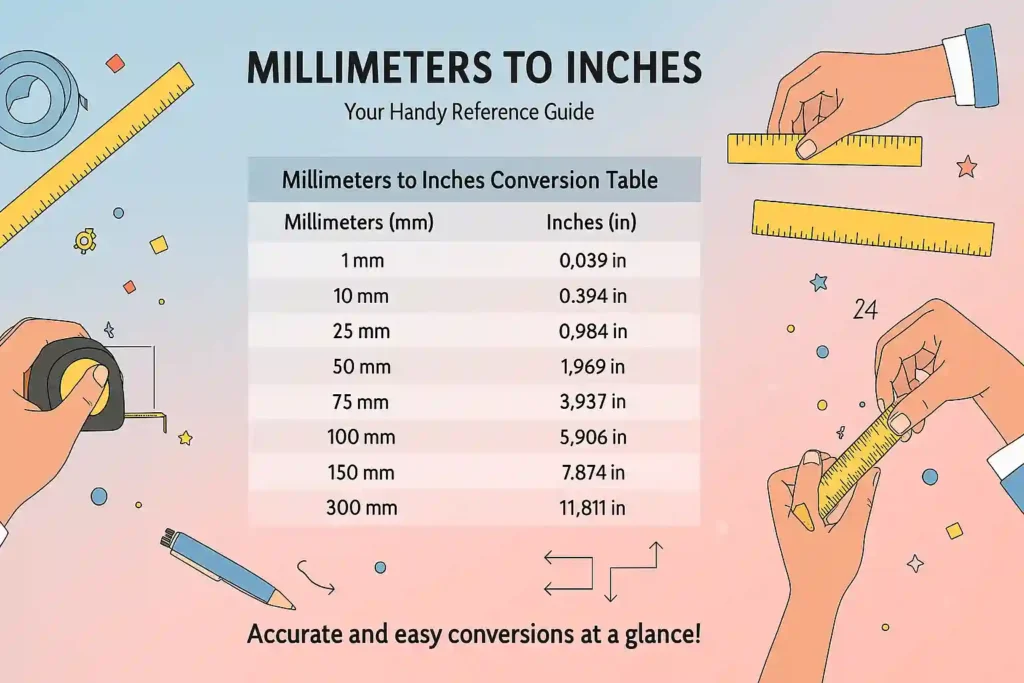Understanding Millimeters and Inches
What Are Millimeters?
Millimeters (mm) are a unit of length in the metric system, widely used around the world. The metric system is based on powers of ten, making it simple and intuitive for calculations. One millimeter equals one-thousandth of a meter, and it is often used to measure small distances or thicknesses, such as the diameter of a pencil lead or the thickness of a credit card.
To give you an idea, here are some examples:
- The thickness of a standard credit card is about 0.76 mm
- A common sheet of paper is approximately 0.1 mm thick
- A standard pencil lead diameter is around 0.5 mm
Millimeters are popular in industries like engineering, manufacturing, and construction because of their precision.
What Are Inches?
Inches (in) are a unit of length in the imperial system, mainly used in the United States and a few other countries. One inch is defined as exactly 25.4 millimeters, making it easy to convert between the two if you know the ratio.
Inches are commonly used to measure:
- Screen sizes (e.g., a 55-inch TV)
- Furniture dimensions
- Height of a person (in feet and inches)
For example:
- A U.S. quarter coin has a diameter of about 1 inch
- A standard sheet of printer paper is 11 inches long
Why Conversion Between Millimeters and Inches Matters
Because the U.S. primarily uses the imperial system and much of the world uses metric, professionals and hobbyists alike often need to convert between millimeters and inches. Whether you’re buying hardware, following a recipe, or working on a DIY project, understanding the conversion can save time and prevent costly mistakes.
You can always remember the key conversion factor: 1 inch = 25.4 millimeters.
In the next sections, we’ll dive into how to convert easily, offer a handy conversion chart, and answer the most common questions people have about mm to inches conversions.

How to Convert mm to Inches
The Basic mm to Inches Conversion Formula
The simplest way to convert mm to inches is to use the standard conversion factor: 1 inch = 25.4 mm. To convert mm to inches, simply divide the millimeter measurement by 25.4.
Formula:
Inches = mm ÷ 25.4For example:
- 50 mm ÷ 25.4 = 1.97 inches
- 10 mm ÷ 25.4 = 0.39 inches
- 100 mm ÷ 25.4 = 3.94 inches
This formula is especially helpful for anyone who needs to convert mm to inches quickly without a calculator.
mm to Inches Conversion Chart
For convenience, here is a handy chart with some common mm to inches conversions:
| Millimeters (mm) | Inches (in) |
|---|---|
| 1 mm | 0.039 in |
| 5 mm | 0.197 in |
| 10 mm | 0.394 in |
| 20 mm | 0.787 in |
| 25 mm | 0.984 in |
| 50 mm | 1.969 in |
| 100 mm | 3.937 in |
| 200 mm | 7.874 in |
| 500 mm | 19.685 in |
| 1000 mm | 39.370 in |
Keeping this mm to inches chart handy can save time when working on woodworking, crafts, or construction projects.
Online Tools for mm to Inches Conversion
If you prefer not to calculate manually, you can use free online tools like the one at RapidTables. Simply enter the millimeter value, and the calculator will instantly display the inches equivalent.
In the next part, we’ll show practical examples of mm to inches conversion in real-life scenarios and address common questions people have about mm to inches measurements.
Practical Examples and FAQs
Real-Life Examples of mm to Inches Conversion
Now that you know how to convert mm to inches, let’s see how it applies in everyday situations:
- Furniture Shopping: If a table is listed as 800 mm wide, dividing by 25.4 gives you about 31.5 inches.
- Craft Projects: When working with fabric measured in millimeters, such as 50 mm ribbon, you know it’s roughly 2 inches.
- Home Renovations: A tile advertised as 300 mm is approximately 11.8 inches, helpful when matching to existing measurements in inches.
These examples show how knowing the conversion can ma
How many mm is 1/8 inch?
1/8 inch equals 3.175 mm. Multiply 0.125 inches by 25.4 to get this value.
Is 20 mm the same as 1 inch?
No, 20 mm is slightly less than an inch. Since 1 inch is 25.4 mm, 20 mm equals about 0.79 inches.
How thick is 2 mm in inches?
2 mm equals about 0.079 inches, a little thicker than a standard credit card.
Is 32 mm equal to 1 inch?
No, 32 mm is larger than 1 inch. 32 mm equals about 1.26 inches.
What is 0.375 in inches?
Since 0.375 is already in inches, it remains 0.375 inches, which is equivalent to 9.525 mm.
What does 5 mm look like?
5 mm is about 0.2 inches roughly the thickness of three stacked pennies.
Conclusion and Helpful Tips
Quick Conversion Hack
If you need a fast estimate without a calculator, remember this rule of thumb: divide mm by 25 for a rough inches approximation. While it’s not exact, it’s close enough for everyday purposes. For example, 50 mm ÷ 25 = 2 inches (exact is 1.97 inches).
Another handy tip is to memorize key benchmarks:
- 25 mm ≈ 1 inch
- 50 mm ≈ 2 inches
- 100 mm ≈ 4 inches
These can help you quickly gauge measurements on the go.
Why Knowing mm to Inches Helps
Whether you’re working on home improvement, shopping for international products, or just curious, understanding how to convert mm to inches makes it easier to communicate dimensions accurately and avoid confusion. Many tools, materials, and specifications list both metric and imperial measurements, so being comfortable with the conversion saves time and frustration. For other handy kitchen and baking measurements, don’t miss our guide on ml to oz conversions.
Explore More Resources
If you often work with both metric and imperial measurements in recipes, our article on gluten-free communion wafers shows how precision matters in baking. Looking for more practical measurement tips? Try our easy sweets with 3 ingredients for quick, precise treats. When working with unusual ingredient quantities, our creamy cheese filling article provides another example of how precise measurements yield better results.
For a more detailed conversion table, step-by-step guides, and a calculator, visit RapidTables mm to inches converter. This free resource allows you to quickly convert any measurement.
Final Thoughts
We hope this guide to mm to inches has been informative and useful. Now you’re equipped to handle these conversions confidently, whether you’re in the kitchen, workshop, or store. For similar guides and helpful measurement hacks, visit our ml to oz conversion page.
For similar guides and helpful measurement tips, be sure to check out our other articles on measurement conversions and DIY project advice. Being accurate with measurements is a small skill that leads to big results!










Leave a Reply